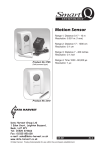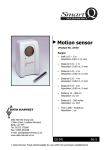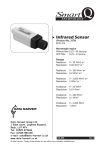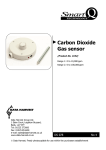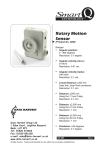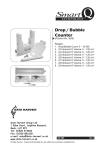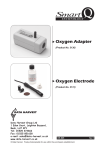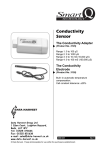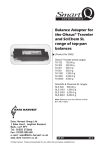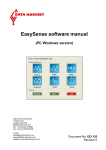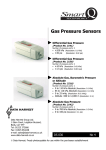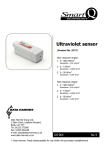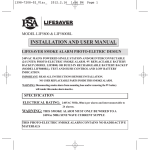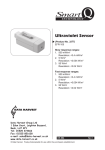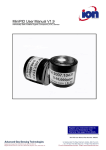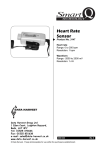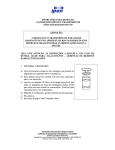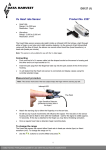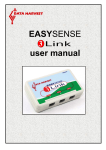Download Smart Geiger Müller Sensor
Transcript
Smart Q TECHNOLOGY Geiger Müller Sensor (Product No. 3265) Range 1: Counts per second (0 – 500 cps) Resolution: 1 cps Range 2: Counts per 10 seconds (0 – 5,000 cp10s) Resolution: 1 cp10s Range 3: Counts per minute (0 – 10,000 cpm) Resolution: 1 cpm Range 4: Open count (0 – 65,535 count) Resolution: 1 count Range 5: Pulse Output (0 – 100%) DATA HARVEST Data Harvest Group Ltd. 1 Eden Court, Leighton Buzzard, Beds, LU7 4FY Tel: 01525 373666 Fax: 01525 851638 e-mail: [email protected] www.data-harvest.co.uk DS 034 © Data Harvest. Freely photocopiable for use within the purchasers establishment No 5 Smart Q Geiger Müller Sensor TECHNOLOGY Introduction ................................................................................................................................ 2 Technical specifications for the Geiger Müller tube................................................................... 2 Connecting................................................................................................................................. 3 Ranges ...................................................................................................................................... 3 Measurement procedure ........................................................................................................... 4 Practical information .................................................................................................................. 5 The Geiger Müller tube.............................................................................................................. 5 Theory........................................................................................................................................ 6 Radioactive decay ..................................................................................................................... 6 Investigations............................................................................................................................. 7 Radioactive decay............................................................................................................. 8 Warranty .................................................................................................................................... 9 Introduction The Smart Q Geiger Müller sensor is used to monitor alpha, beta, and gamma radiation. The Sensor consists of the Geiger Müller adapter, a Geiger Müller counter and a steel rod. The Geiger Müller counter is a GM tube with built-in integral high tension power supply. It has a yellow LED power indicator that indicates when an operational voltage is supplied to the Counter, and a buzzer that emits an audible signal for each radioactive pulse that is recorded. The Geiger Müller (GM) sensor becomes active and will start to count as soon as it receives power from the EASYSENSE unit. Use the reset zero button (located near the Smart Q label) to reset an open count to zero. The GM tube’s window is made of a very thin sheet of mica, which is a delicate material, easily destroyed. To protect this window the tube is fitted with a protective cap that should be left on except when measuring alpha radiation. The cap is provided with a ventilating hole to avoid creating a vacuum when removing the cap or the opposite when replacing it. Important: The venting hole must be uncovered when replacing or removing the cap. The GM sensor is supplied with a steel rod that can be screwed into the mounting thread at the base of the GM counter. The rod can be used for clamping into a suitable holding device e.g. a retort stand. Technical specifications for the Geiger Müller tube Window specifications: Thickness: 1.5 to 2.0 mg/cm2 Useful diameter: 9.14 mm Material: Mica Gas filling: Neon, Argon, and Halogen 2 Smart Q Geiger Müller Sensor TECHNOLOGY Connecting Power indicator Geiger Müller counter Geiger Müller adapter Reset to zero Venting hole Push one end of the sensor cable (supplied with the EASYSENSE unit) into the hooded socket on the adapter with the locating arrow on the cable facing upwards. Connect the other end of the sensor cable to an input socket on the EASYSENSE unit. Connect the jack plug from the GM counter to the jack socket on the adapter. The yellow power light indicator on the Counter will light to indicate that it is being supplied with an operating voltage. The EASYSENSE unit will detect that the GM Sensor is connected and display values using the currently selected range. If the range is not suitable for your investigation, set the correct range. The GM sensor becomes active and will start to count as soon as it’s connected and receives power from the EASYSENSE unit. It will draw power even when data is not being collected so disconnect when not in use. Ranges The V1.2 GM Sensor has five ranges available to use. 1. 1 second count – 0 to 500 cps - measures the total number of counts that the Sensor detects in the preceding one second period. The value is updated at one second intervals. 2. 10 second count – 0 to 5,000 cp10s - measures the total number of counts that the Sensor detects in the preceding 10 second period. The value is updated at ten second intervals. 3. 1 minute count – 0 to 10,000 cpm - used to measure the total number of counts that the Sensor detects in the preceding one minute period. The value is updated at one minute intervals. The 1 second, 10 second, and 1 minute count ranges are useful for investigations to determine half life, and absorption of radiation by different materials. The GM sensor will start to count as soon as it’s connected and receives power from the EASYSENSE unit. It will return a value of zero until updated at the end of its first time interval e.g. when using the one minute count range the value will remain at zero until one minute after its started counting. 3 Smart Q Geiger Müller Sensor TECHNOLOGY 4. Count time open (Open Count) - 0 to 65,535 - used to measure a total accumulated count. The GM sensor will start to count as soon as it’s powered by the EASYSENSE unit. Press the reset zero button (located near the Smart Q label) down for at least a second to reset a count to zero. If the count reaches the maximum value (65,535), it will automatically drop down to zero and start counting again. Useful for recording background count, calculating the average count from the time the count has run for and absorption of radiation by different materials 5. Pulse Output - 0 to 100%. Each radioactive particle will generate one voltage pulse. The occurrence of the pulse is recorded to show the randomness of atomic decay. Data needs to be collected with an intersample time of less than 200 μS or the pulse may not be seen. To alter the currently selected range: Connect the GM sensor to the EASYSENSE unit. Start the EASYSENSE program and select one of the logging modes from the Home screen e.g. EasyLog. Select Sensor Config from the Settings menu. Select the GM Sensor from the list (it will be listed using its current range) and click on the Change Range button. The current range will be highlighted. Select the required range and click on OK. Close Sensor Config. Click on New and then Finish for the change in range to be detected. The range setting will be retained until changed by the user. With some EASYSENSE units it is possible to change the range from the unit. Please refer to the EASYSENSE unit’s user manual. Measurement procedure Radioactive sources used in schools are usually weak, but care must be taken in handling them. An authorised person must be in attendance. Ensure that all local rules and recommendations made in any relevant Safety Data Sheets are complied with. Prepare a risk assessment before the experiment or activity is carried out. Safety: If handling radioactive sources, always use tongs or other holder. Do not hold a source close to yourself or anyone else. Wash your hands afterwards. Sources should be stored appropriately in a locked and labelled store. Radioactive • With the radioactive sources removed far from the GM sensor, count the background radiation in the room for at least two minutes. This will determine whether the ‘background’ radiation is negligible or not. This value can be subtracted from subsequent rate measurements using a Post-log Function. 4 Smart Q Geiger Müller Sensor TECHNOLOGY • If being used to detect alpha radiation: Make sure that the venting hole is uncovered and carefully remove the protective cap. Place the suspect source of radiation within 6 mm of the GM tube’s window without it touching (alpha radiation will not travel far through air). When the investigation has finished, make sure the venting hole is uncovered and replace the cap. • If being used to detect beta or gamma radiation: Check the protective cap is in place. Point the GM tube towards the source of radiation. Practical information • The GM sensor takes its power direct from the EASYSENSE unit. It will use power even when it is not taking any samples. Disconnect the adapter when not in use. • The GM sensor becomes active and will start to count as soon as it receives power from the EASYSENSE unit. • Excluding the Pulse output range, the fastest speed that data can be captured is 50 Hz (20 ms). If an intersample time of less than 20 milliseconds is selected, then the values obtained will either default to the lowest reading or the set up will be rejected by the logger/software. • The GM tube’s window is made of mica, a very thin and delicate material, which is easily destroyed. If the window is damaged this would render the Counter unusable. For this reason it has been equipped with a protective cap that may be left on except when measuring alpha radiation. The cap is provided with a ventilating hole to avoid vacuum when removing or when replacing it. Important: The venting hole must be uncovered when replacing or removing the cap. • Do NOT insert objects into the tube. If the GM tube is to be used in a vertical position, place it above the specimen to be tested in order to avoid particles falling onto and damaging the window. To correct for background count: 1. Press the reset zero button and establish the average value for background count e.g. by using Test mode. 2. Select either a Pre-log or Post-log Function from the Tools menu. (Use Pre-log before data has been recorded - the set of data will be created as logging progresses. Use Postlog when data has already been recorded). 3. Select Preset function, General, Tare, Next. Select the GM sensor as the channel to use, Next. Enter a name to identify the data as the corrected set, the average background count value in Parameters and Finish. The Geiger Müller tube The GM tube is sealed and contains gas at low pressure. The thin mica window at the end of the tube allows alpha and beta particles to enter from outside. Gamma radiation can also enter via the plastic case of the tube. Inside the tube each particle or ray ionises several gas atoms. The positive ions are attracted to the cathode, negative electrons to the anode. The ions accelerate because of the electric field and they collide with other atoms, producing more ions and electrons. These secondary ions are accelerated too and they collide with other atoms to create even more ions, which are discharged at the electrodes. As the ions are 5 Smart Q Geiger Müller Sensor TECHNOLOGY discharged, the potential difference between the cathode and anode changes briefly to supply a voltage pulse. Theory Radiation is present on Earth (in relatively small amounts) originating both from natural and unnatural sources. One notable natural source is carbon-14, which is taken in by plants and animals. This is constantly being produced from stable nitrogen-14 due to bombardment by cosmic rays (entering the atmosphere from outer space). Radioactivity is a property of unstable nuclei. It involves the nuclei breaking up spontaneously into nuclei of other elements and emitting rays or particles (radiation), a process known as radioactive decay. A radioactive element is one whose nuclei are gradually splitting up in this way. There are three types of radiation emitted by radioactive elements: streams of alpha particles referred to as alpha rays, streams of beta particles (beta rays) and gamma rays. Alpha particles (α – particle) These are one type of particle emitted from the nucleus of a radioactive atom. They are positively–charged, relatively heavy (two protons and two neutrons), move relatively slowly and have low penetrating power. Alphas typically have a range of only a few cm in air. Particles are absorbed by thin card or by travelling 10 – 20 cm in air, or by the skin. Beta particle (β – particle) These are fast moving particles, ejected from some radioactive nuclei at about the speed of light. The beta particle is an electron. They can penetrate objects that have a low density and/or thickness, such as paper, but a thin sheet of aluminium will absorb them. Typically their maximum range in air is 30 cm. Radiation source α - particle β - particle γ - particle Thin card Aluminium sheeting Lead block Gamma rays (γ – rays) Gamma rays are electromagnetic radiation that is emitted by the nucleus of an atom. They have a very short wavelength (shorter than X –rays) and are very energetic. Theses rays are very penetrating. They are reduced, but not stopped by several cm of lead. To determine whether the radiation is alpha, beta or gamma: Follow the procedure for detecting alpha radiation (see page 5). Place a piece of thick card between the radioactive source and the GM tubes window, if the radioactive pulses stop, the radiation is likely to be alpha. If the pulses continue, place a 3 mm thick aluminium sheet between the window & the source. If the pulses stop, the radiation is likely to be beta. If the pulses continue, the radiation is likely to be gamma. Radioactive decay Radioactive decay is the process whereby the nuclei of a radioactive element undergo a series of disintegrations (a decay series) to become stable. It is impossible to predict which nucleus will become unstable enough to decay next, however it is possible to use the GM sensor to count the number of nuclei which do decay per second in a radioactive sample. The Half-life is the time 6 Smart Q Geiger Müller Sensor TECHNOLOGY taken for half of the atoms in a sample to undergo radioactive decay, and hence the radioactive pulses emitted to be halved. Radioactive isotopes are atoms or ions of the same element but with different numbers of protons and neutrons (nucleons) i.e. the same number of protons but a different number of neutrons. The half-life of radioactive isotopes vary widely, some examples are listed in the table below. Element Isotope Emission Half-life Americium Am-241 α 458 years Barium Ba-133 γ 10.5 years Cobalt Co-60 βγ 5.27 years Co-57 γ 271 days Co-57 β 270 days Cadmium Cd-109 γ 464 days Caesium Cs-137 βγ 30.2 years Carbon C-14 β 5730 years Iodine I-131 β 8.1 days Manganese Mn-54 γ 313 days Plutonium Pu-240 α 6580 years Polonium Po-210 α 138 days Potassium K-40 β 1.3 x 109 years Uranium U-235 α 7.1 x 108 years Strontium Sr-90 β 28.6 years Sodium Na-22 β+ γ 2.60 years Na-24 γ 15 hours Tl-204 β 3.78 years Thallium Units of measurement Radioactive sources have to be measured in terms of their activity rather than their mass. An activity of one decay a second is called a bequerel (Bq). Sources used to be measured in curies (Ci). A curie = 3.7 x 1010 Bq The dose of radiation received by a person is measured in units called sieverts (Sv), which take into account the type of radiation and the organs affected. The effect of radiation on human tissue is different for the three types, alpha radiation releasing about 20 times more energy per unit travel in tissue. Investigations • Background radiation • Locating radiation hot spots due to mineral deposits • Increased radiation in enclosed spaces due to Radon production and retention • Effect of distance from the source on Count rate – the attenuation of the radiation will depend on two factors: 1. Inverse square law 7 Smart Q Geiger Müller Sensor TECHNOLOGY 2. Absorption by the medium - in the case of gamma rays in air there is very little absorption, but absorption plays the main role with alpha and beta rays. • Radioactive half life decay curves e.g. Protactinium • Activity of different radioactive sources • Radioactive penetration through different materials placed between the source and GM tube Radioactive decay Protactinium has a half-life of just 72 seconds and makes an ideal radioactive source for this experiment. The count rate is measured as time passes and the measurements used to calculate the half-life of the material. One method of determining the half-life of a source is: - 8 Smart Q Geiger Müller Sensor TECHNOLOGY 1. If necessary alter the X-axis so it displays Time in seconds. 2. Smooth the collected data (Tools, Smoothing) – the data in this graph has been smoothed to a level of 30, and the axis limits altered to 0 – 35 cps. 3. Click on the graph or table to select a point on the curve and note the value shown in the data value box e.g. 16 cps. 4. Select the Interval icon and drag the cursor to the right until the value (shown in the data box) is half of the first value e.g. 16/2 = 8 cps. The information box will show the time taken for the count rate to have fallen by half (the half-life) e.g. Interval from 116 to 188 = 72 s. 5. Repeat step 3 & 4 at different points along the graph and average the results e.g. 22 to 11 cps = 88 s, 20 to 10 cps = 82 s, 18 to 9 cps = 76 s, 16 to 8 cps = 72 s, 14 to 7 cps = 69 s, 12 to 6 cps = 67 s, 10 to 5 cps = 60 s. Average = 73 s. Warranty All Data Harvest Sensors are warranted to be free from defects in materials and workmanship for a period of 12 months from the date of purchase provided they have been used in accordance with any instructions, under normal laboratory conditions. This warranty does not apply if the Sensor has been damaged by accident or misuse. In the event of a fault developing within the 12 month period, the Sensor must be returned to Data Harvest for repair or replacement at no expense to the user other than postal charges. Note: Data Harvest products are designed for educational use and are not intended for use in industrial, medical or commercial applications. WEEE (Waste Electrical and Electronic Equipment) Legislation Data Harvest Group Ltd is fully compliant with WEEE legislation and is pleased to provide a disposal service for any of our products when their life expires. Simply return them to us clearly identified as ‘life expired’ and we will dispose of them for you. 9









